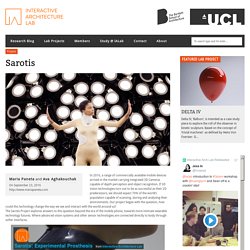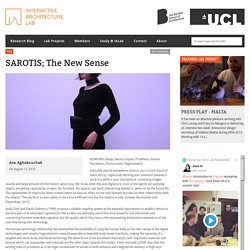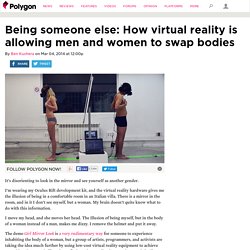

Interactive Architecture Lab. In 2016, a range of commercially available mobile devices arrived in the market carrying integrated 3D Cameras capable of depth perception and object recognition.

If 3D vision technologies turn out to be as successful as their 2D predecessors, we should expect 70% of the world’s population capable of scanning, storing and analysing their environments. Our project began with the question, how could this technology change the way we see and interact with the world around us? The Sarotis Project explores answers to this question beyond the era of the mobile phone, towards more intimate wearable technology futures. Where advanced vision systems and other sensor technologies are connected directly to body through softer interfaces. Sarotis Experimental Prosthesis Here we present a two phased study. a series of technical experiments and a speculative film. Still 01 from Sarotis Speculative Short Film Still 02 from Sarotis Speculative Short Film. Interactive Architecture Lab. KEYWORDS: Body, Sensory Inputs, Prosthesis, Human Perception, Environment, Augmentation Delicately placed somewhere close to you is a slim block of black mirror.

Vigorously deriving your attention towards it once in a while is your smartphone, containing images, sounds and large amount of information about your life. As we enter the post-digital era, most of the significant everyday objects are getting replaced by screens. No furniture. No objects. Andy Clark and David Chalmers [1998] propose a reliable coupling system as the essential requirement to enable a device to become part of an extended cognition[2].
The human-technology relationship has exemplified the possibility of using the human body as the next canvas of the digital technologies and raised a huge attention towards wearable or bearable body based interfaces, making the necessity of a tangible and smart body-interfaced technology the latest focus of the prosthesis theories[3]. 1. Simple Animatronics (robotic hand) Simple and cheap ROBOT HAND using only ONE MOTOR! - All. Hi everybody, I just wanted to share this idea to make a simple, cheap robotic hand (or any end effector) using only one motor.

Using only ONE motor for the whole hand allows the hand to be: - extremely cheap, which is good for your wallet because usually servomotor are quite expensive - extremely light, which is good for your project because usually the main problem of an end effector is to be too much heavy, because the distance from the center of gravity of the robot multiplies its weight. Of course, if you need to make a complex animatronic hand, capable of moving each finger individually, there's no choice, you will need a motor for every finger/ group of fingers you want to move separately.But, if you want to make a simple but effective end effector for your DIY robot, probably you should consider the idea of using just one motor for the whole hand! In the video above you can see how the hand is made, and some test of the gripper. I hope this can be useful to somebody! Step by step how to build a robotic hand with cheap material.
BeAnotherLab. The Machine to Be Another: art investigation using embodiment and performances. Being someone else: How virtual reality is allowing men and women to swap bodies. It’s disorienting to look in the mirror and see yourself as another gender.

I’m wearing my Oculus Rift development kit, and the virtual reality hardware gives me the illusion of being in a comfortable room in an Italian villa. There is a mirror in the room, and in it I don’t see myself, but a woman. My brain doesn’t quite know what to do with this information. I move my head, and she moves her head. The illusion of being myself, but in the body of a woman instead of a man, makes me dizzy. The demo Girl Mirror Look is a very rudimentary way for someone to experience inhabiting the body of a woman, but a group of artists, programmers, and activists are taking the idea much further by using low-cost virtual reality equipment to achieve something that sounds like science fiction: They’re allowing people to trade bodies.
Becoming someone else Warning: the videos in this story contain nudity and may be considered not safe for work. "How would you feel to swap your body with another? " Dr. Dr. Dr. Labor Pain Simulation. Simulation-based learning: Just like the real thing. Through Your Child’s Eyes Tool. Welcome to our website « Simulation Experience. Training simulation. This article is about educational training simulations.

For business video games for entertainment purposes, see business simulation game. A training simulation is a virtual medium through which various types of skills can be acquired.[1] Training simulations can be used in a wide variety of genres; however they are most commonly[2] used in corporate situations to improve business awareness and management skills. They are also common in academic environments as an integrated part of a business or management course. The word simulation implies an imitation of a real-life process, usually via a computer or other technological device, in order to provide a lifelike experience.